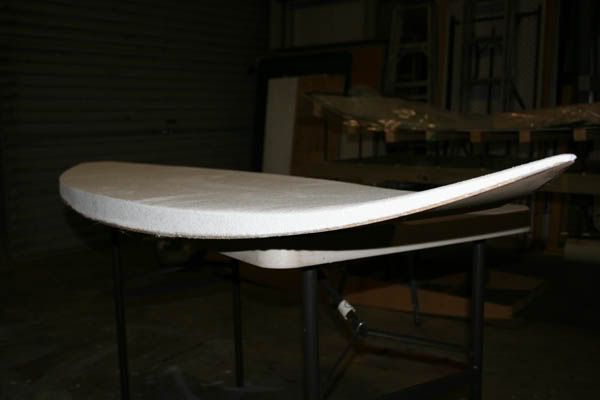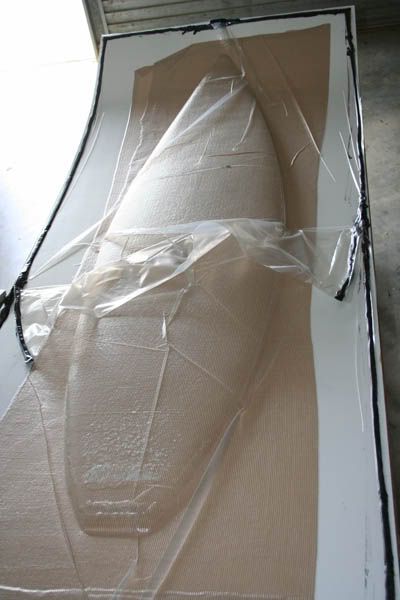Page 2 of 8
Re: Gibber's compsand build thread.
Posted: Thu Nov 18, 2010 9:54 am
by daryl
What makes 'breather cloth' stick under vacuum?
Re: Gibber's compsand build thread.
Posted: Thu Nov 18, 2010 10:23 am
by tiger
Daz the breather cloth doesn't stick to anything, It is just being pulled down by the bag. Without it the bag will suck down on to the table where the hose enters the bag. By covering the entire job, and the suction entry point you get an even pressure without any air locks. It's just shadecloth if your intrested.
Re: Gibber's compsand build thread.
Posted: Thu Nov 18, 2010 10:29 am
by daryl
second try
what makes the skin stick under vacuum?

Re: Gibber's compsand build thread.
Posted: Thu Nov 18, 2010 10:53 am
by gibber
Daz, think of vacuum as being like a big clamp.
You still need an adhesive between the two surfaces though, that's what performs the "sticking". The vacuum presure just holds everything in place whilst the sticking application goes through it's cure
The breather (in this case shade cloth) allows am all over distribution of vacuum pressure globally throughout the bag; ie. Equal pressure across the whole sticking surface
Re: Gibber's compsand build thread.
Posted: Thu Nov 18, 2010 11:27 am
by daryl
tiger wrote:Out of the bag, bottom skin on.


this one made me think the breather was stuck on, the way fibreglass is stuck on by resin.
There is some adhesive then, and what is the skin, thin hard plastic sheeting?
Re: Gibber's compsand build thread.
Posted: Thu Nov 18, 2010 11:33 am
by tiger
Skin is 3mm thick, high density foam. It's stuck to the polystyrene core foam by a layer of 4oz f/glass cloth, wet out with epoxy resin.
Re: Gibber's compsand build thread.
Posted: Thu Nov 18, 2010 12:08 pm
by daryl
and vacuum bagging is the only way, or do you do it that way because
it's quick and sets the rocker so it stays bent
Re: Gibber's compsand build thread.
Posted: Thu Nov 18, 2010 12:32 pm
by gibber
Both types of foam are predominately flat in their static form, so for them and the wet galas between to be held down onto the rocker table you need to clamp it in place ie, the vac bag. Vacuum does escalate the cure time too but it's not really factored in too much. Eg if you were climbing everest, it takes less energy to boil water at high elevation due to lack of air pressure, same kinda goes for resin cure rates
Re: Gibber's compsand build thread.
Posted: Thu Nov 18, 2010 12:35 pm
by gibber
Sorry I meant glass not galas (galahs)
No birds are hurt during the building of these boards
Re: Gibber's compsand build thread.
Posted: Thu Nov 18, 2010 1:28 pm
by daryl
^
the skin is the main diff between compsand and a PU with stringer?
tho the stringer is probly about as much a main difference too?
Re: Gibber's compsand build thread.
Posted: Thu Nov 18, 2010 2:00 pm
by gibber
In an engineering sense, the skinned system is a far beret build type in terms of strength over weight. Have a look at an internal doors construction in your home. The door consists of two skins of ply either side of a cardboard hexcell core, it's light and stiff and strong. Same thing goes for the composite or colorant board. The skins are far stronger (terrible word engineering wise but you know what i mean by using it) with the PVC foam and glass than with a standard glass skin on pu foam. They both display the same concept; that being a skin over a light weight core, it's just the styrene foam/PVC foam and glass system results in a stiffer and harder/tougher finish.
The real trick is to remove stiffness when building a compsand board so that it will be the same as a pu board therefore no stringers are used.
Does this answer your question? I may have gone off topic a bit but I reckon the answer is in there...somewhere
Re: Gibber's compsand build thread.
Posted: Thu Nov 18, 2010 3:03 pm
by daryl
gibber wrote:In an engineering sense, the skinned system is a far beret build type in terms of strength over weight. Have a look at an internal doors construction in your home. The door consists of two skins of ply either side of a cardboard hexcell core, it's light and stiff and strong. Same thing goes for the composite or colorant board. The skins are far stronger (terrible word engineering wise but you know what i mean by using it) with the PVC foam and glass than with a standard glass skin on pu foam. They both display the same concept; that being a skin over a light weight core, it's just the styrene foam/PVC foam and glass system results in a stiffer and harder/tougher finish.
The real trick is to remove stiffness when building a compsand board so that it will be the same as a pu board therefore no stringers are used.
Does this answer your question? I may have gone off topic a bit but I reckon the answer is in there...somewhere
I think it makes me wonder if the Sunova wafer board at home was too stiff for me and it wasn't all my lousy paddling

Re: Gibber's compsand build thread.
Posted: Thu Nov 18, 2010 8:17 pm
by PeepeelaPew
...
Re: Gibber's compsand build thread.
Posted: Wed Nov 24, 2010 2:58 pm
by tiger
Got the deck on today.

Re: Gibber's compsand build thread.
Posted: Fri Nov 26, 2010 10:15 pm
by mustkillmulloway
Re: Gibber's compsand build thread.
Posted: Sat Nov 27, 2010 11:07 am
by tiger
Dunno about sexy, but it sure is interesting. Good fun making boards in such a different way. It's like you're making the blank and everything from scratch, and using totally different methods and tools to shape.
Cranking the pump, watching all the air suck out of the bag and wrap around the curves.......OK I'll admit it's sexy, I've got a hard-on for it.
Re: Gibber's compsand build thread.
Posted: Tue Nov 30, 2010 8:10 am
by ric_vidal
Hey Tiger, how’s it go with the shaping of the different densities and glue?
Only did a bit of experimenting myself and never got my head around a suitable method.
Keep it coming.
Re: Gibber's compsand build thread.
Posted: Tue Nov 30, 2010 11:23 am
by tiger
Hey Ric, how are you mate?
The idea is to limit any shaping where there will be difference in density. I'm just sticking PU rails on this one, so the outside perimeter of the board will be 3/4" of PU foam. The main problem area with the density change would be the tucked under edge on the bottom of the rail, so this way it all can be done within the PU rail strip. The density change is quite easy to handle on the shoulder of the rail, and on the flat of the bottom.
I'm really only using PU rail because I have them readily available as railband offcuts from regular boards, and it's easy for me to use on these preliminery models while I get experience with the procedures/construction methods. They have to be beefed up in the glassing process, or it kinda defeats the purpose when you are trying to make a more durable board. So I'll be trying different materials on the rails in the future.
